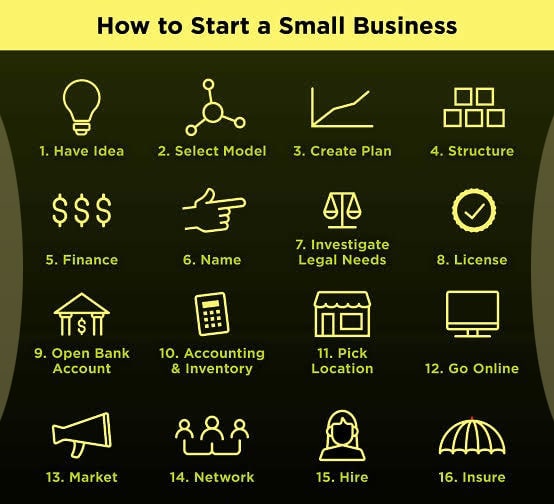How to Start a Small Business: Step-by-Step Guide for Beginners
Starting a small business can be one of the most rewarding journeys of your life. It offers independence, potential financial freedom, and the satisfaction of building something from scratch. However, turning your idea into a successful venture involves more than just passion—it requires strategic planning, legal steps, and marketing know-how.
In this comprehensive guide, we will break down how to start a small business using 16 essential steps, inspired by the insightful roadmap from FinImpact. Whether you’re a first-time entrepreneur or looking to formalize your side hustle, this guide covers everything you need.

Step 1: Have an Idea
Every great business starts with a solid idea. Think of a product or service that solves a real problem, satisfies a demand, or adds value in a unique way. Consider what you're passionate about and where your skills align with market needs.
Tip: Validate your idea by discussing it with potential customers, doing online surveys, or analyzing current market trends.
Step 2: Select a Business Model
Selecting an appropriate business model shapes the way you provide value to customers and earn income from your offerings. Will you sell directly to customers (B2C), serve other businesses (B2B), run a subscription-based service, or operate through e-commerce?
Popular models include:
Dropshipping
Franchising
Manufacturing
Consulting
Online services
Step 3: Create a Business Plan
A comprehensive business plan acts as a guiding blueprint for building and growing your venture. It should outline your goals, target audience, pricing strategy, operations plan, marketing tactics, and financial forecasts.
Pro tip: A strong business plan can also help attract investors or secure loans.
Step 4: Choose a Legal Structure
Deciding on the right legal structure is crucial. Each structure comes with different tax implications, liability risks, and documentation requirements.
Common types:
Step 5: Arrange Finances
Evaluate the amount of funding required to launch and sustain your business operations. This includes rent, equipment, staff, licensing, and marketing. Explore options like:
Personal savings
Loans from banks or NBFCs
Angel investors or venture capital
Government grants and schemes for small businesses
Step 6: Choose a Business Name
Choose a business name that aligns with your brand identity, is memorable, and can be registered as a domain and trademark without conflicts. A strong business name helps create a professional image and improves brand recall.
Step 7: Investigate Legal Requirements
Before you begin operations, understand the legal obligations associated with your business. This includes:
Industry-specific licenses
Compliance with labor laws
Environmental or safety regulations
Data protection rules (if applicable)
Step 8: Register and License Your Business
Get your business officially registered to gain legal recognition and avoid future disputes. Depending on your country and structure, you may need:
Step 9: Open a Business Bank Account
Keep your personal and business finances separate by opening a current account in your company’s name. It improves credibility and simplifies accounting.
Benefits include:
Step 10: Set Up Accounting and Inventory Systems
Implementing a good accounting system helps you track income, expenses, profits, and losses. Choose accounting software suited for small businesses, and if applicable, integrate inventory management.
Popular tools:
QuickBooks
Zoho Books
Tally
Wave
Step 11: Pick Your Business Location
Location can significantly impact your business. Depending on your model, you may choose a retail space, office, co-working hub, or even operate from home.
Factors to consider:
Target customer base
Accessibility
Rent and overhead costs
Zoning laws
Step 12: Build an Online Presence
In today's digital age, going online is non-negotiable. Start by:
Creating a professional website
Setting up business profiles on Google and social media
Investing in SEO and digital marketing
Bonus Tip: Consider e-commerce platforms like Shopify, WooCommerce, or Amazon to reach a broader audience.
Step 13: Market Your Business
Effective marketing helps you reach potential customers and build trust. Use a mix of:
Social media marketing
Email campaigns
Influencer partnerships
Local advertising
Word of mouth
Step 14: Build a Network
Networking opens doors to mentorship, partnerships, and business opportunities. Attend trade shows, join industry groups, and engage in online forums or LinkedIn groups.
Your network can become your net worth.
Step 15: Hire the Right People
As your business grows, you may need to bring in talent. Focus on hiring individuals who align with your mission and culture.
Start with roles like:
Marketing and sales
Customer support
Operations
Finance or bookkeeping
Consider freelancers or part-time hires initially to manage costs.
Step 16: Insure Your Business
Protect your business from unexpected risks by getting the right insurance. Some essential types include:
Insurance not only safeguards assets but also builds trust with clients and partners.
Final Thoughts
Starting a small business may seem overwhelming, but when broken into these 16 actionable steps, it becomes manageable and strategic. From having an idea to hiring staff and protecting your venture with insurance, each step plays a vital role in long-term success.
Whether you’re launching a local startup or building an online empire, following this step-by-step guide will help you lay a strong foundation. Take your time, do your research, and don’t be afraid to seek advice or mentorship. Every big business once started small—yours could be next.